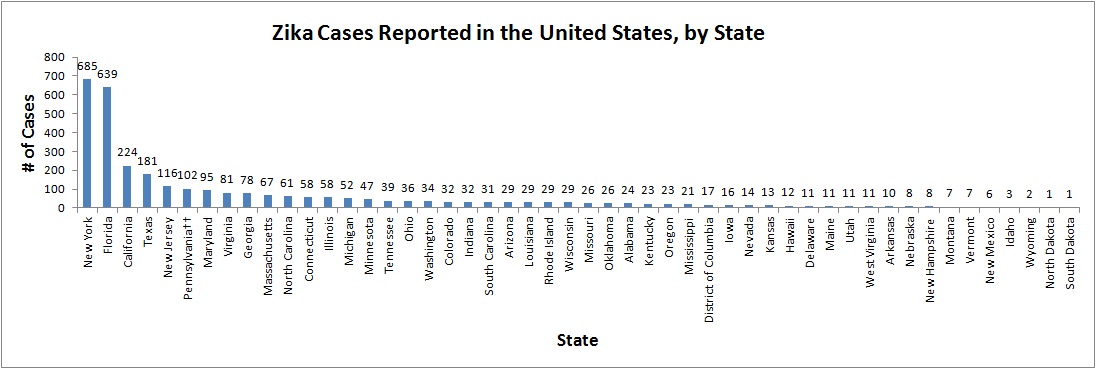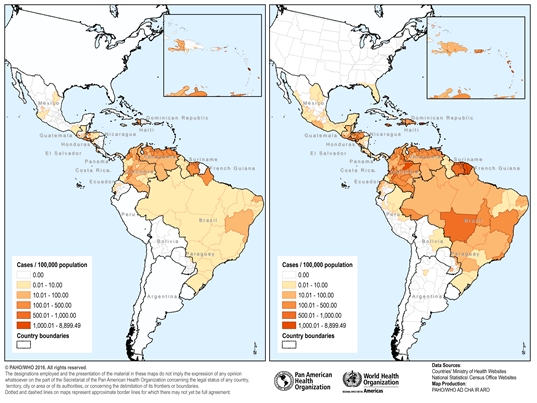Zika virus infection epidemiology and demographics
|
Zika virus infection Microchapters |
|
Diagnosis |
|
Treatment |
|
Case Studies |
|
Zika virus infection epidemiology and demographics On the Web |
|
American Roentgen Ray Society Images of Zika virus infection epidemiology and demographics |
|
Zika virus infection epidemiology and demographics in the news |
|
Risk calculators and risk factors for Zika virus infection epidemiology and demographics |
Editor-In-Chief: C. Michael Gibson, M.S., M.D. [1]; Associate Editor(s)-in-Chief: Yazan Daaboul, M.D.; Luke Rusowicz-Orazem, B.S.; Serge Korjian M.D.; Yamuna Kondapally, M.B.B.S[2]
Overview
In 2015, Zika virus infection outbreaks rose dramatically, particularly in Brazil as observed by the manifestation of a correlated complication, microcephaly, in infants born to mothers with Zika virus infection, an incidence of approximately 100 per 100,000 infants. The majority of Zika virus infection cases are reported in South Africa and Tropical Asia. As of 2014, Zika Virus infection outbreaks have also become more common in South America. Cases reported in other regions of the world are attributed to travel from areas with outbreaks. Zika virus infection affects all age groups, with newborn infants particularly vulnerable due to risk of transmission from the mothers upon birth.
Epidemiology and Demographics
Incidence
- As only 1 in 5 people with Zika virus usually becomes symptomatic, and given that the symptoms are generally mild, it is hard to establish a clear incidence of the infection.
- The incidence of Zika virus infection is often correlated to the one of its circumstantially associated complications: microcephaly
- Based on this method, the incidence of Zika virus infection in increasing.
- As of November 2015, it is estimated that 99.7/100,000 live births of infants displaying microcephaly could be attributed to Zika virus.
- This is a twentyfold increase from 2010's report of 5.7/100,000 cases.[1]
U.S. Reported Cases
- There have been cases of local level transmission in the continental United States.[2]

†Data based on CDC (2016).[2] Figure owned by WikiDoc - must be redistributed!
- Laboratory-confirmed Zika virus disease cases reported to ArboNET by state or territory (as of September 14, 2016).[2]
Countries
- American countries with local Zika virus transmission in 2015-2016 outbreak include:[3]
Americas
- According to Pan American Health Organisation (WHO regional office for Americas), 46 countries and territories have confirmed indigenous vector-borne transmission of Zika virus in the region of Americas since 2015(most recent update September 8, 2016).[4]
- Five countries in Americas reported sexually transmitted Zika cases.
- Argentina
- Canada
- Chile
- Peru
- The United States of America.
- The British Virgin Islands have also confirmed vector borne autochthonous transmission of Zika virus.
North America
- Mexico: Showing downward trend on number of confirmed cases.
- United States of America: Zika transmission continues to expand.
- Florida: Three counties in the Florida has confirmed autochthonous cases of Zika Virus infection.
- Miami Dade
- Palm Beach
- Pinellas
- Florida: Three counties in the Florida has confirmed autochthonous cases of Zika Virus infection.
Central America
- Central America has decreasing cases of trend of cases except in Costa Rica, where there has been increasing trend of cases since the beginning of outbreak.
- Between late 2015 and early 2016, there was greatest increase in Zika cases in Central America.
Caribbean
- The Caribbean countries are showing decreasing trends.
South America
- All countries of South America are showing decreasing trends.
| North America | Central America | Caribbean | South America |
|---|---|---|---|
| • Miami Dade • Palm Beach • Pinellas |
• Belize • Costa Rica • El Salvador • Guatemala • Honduras • Nicaragua • Panama. |
• Anguilla • Antigua and Barbuda • Aruba • The Bahamas • Barbados • Bonaire • Saint Eustatius and Saba • Curacao • Cayman Islands • Cuba • Dominica • The Dominican Republic • Grenada • Guadeloupe • Haiti • Jamaica • Martinique • Puerto Rico • Saint Barthélemy • Saint Lucia • Saint Martin • Sint Maarten • Saint Vincent and the Grenadines • Trinidad and Tobago • Turks and Caicos Islands • The U.S. Virgin Islands. |
• Argentina • Bolivia • Brazil • Colombia • Ecuador • French Guiana • Guyana • Paraguay • Peru • Suriname • Venezuela. |
- Incidence rates of Zika cases (suspected and confirmed) in the Americas, January 2016 and September 2016.[4]
Age
Gender
- Men and women are equally affected by Zika virus infection.
World
- While Zika virus infection outbreaks have not been reported in developed countries, cases have been reported in travelers returning from affected countries.[6]
- No autochthonous cases of Zika virus infection have been reported in Europe or the United States.[7]
- Before 2007, Zika virus infection outbreaks reports were limited to Tropical Africa and Southeast Asia. However, an outbreak on Yap Island in the Federated States of Micronesia in 2007 was the first of several cases reported on Pacific islands and archipelagos outside of Africa and Asia.[8]
- Zika virus infection outbreaks have mainly been reported in Mexico and South America.[8]
- The first South American outbreak was reported originating in Easter Island, Chile, in 2014.

- Countries with local Zika virus transmission in 2015-2016 outbreak include:[1]
References
- ↑ 1.0 1.1 1.2 "Epidemiological Alert: Neurological Syndromes, Congenital Malformations, and Zika Virus Infection. Implications for Public Health in the Americas". Pan American Health Organization. Pan American Health Organization. December 1, 2015. Retrieved December 11, 2015.
- ↑ 2.0 2.1 2.2 Reported cases http://www.cdc.gov/zika/intheus/maps-zika-us.html (September 14, 2016) Accessed on September 16, 2016
- ↑ Incidence and trends http://www.paho.org/hq/index.php?option=com_content&id=11599&Itemid=41691 (September 8, 2016) Accessed on September 16, 2016
- ↑ 4.0 4.1 WHO http://www.paho.org/hq/index.php?option=com_content&id=11599&Itemid=41691 (September 8, 2016) Accessed on September 15, 2016
- ↑ "Zika Virus: Geographical Distribution". CIDRAP Center for Infectious Disease Research and Policy. University of Minnesota. December 1, 2015. Retrieved December 14, 2015.
- ↑ Schnirring, Lisa (December 11, 2015). "PAHO Issues Zika Virus Alert". CDC.Gov. Center for Disease Control. Retrieved December 14, 2015.
- ↑ Epidemiological update: Outbreaks of Zika virus and complications potentially linked to the Zika virus infection. ECDC (2016). http://ecdc.europa.eu/en/press/news/_layouts/forms/News_DispForm.aspx?ID=1342&List=8db7286c-fe2d-476c-9133-18ff4cb1b568&Source=http%3A%2F%2Fecdc%2Eeuropa%2Eeu%2Fen%2Fhealthtopics%2Fzika%5Fvirus%5Finfection%2FPages%2Findex%2Easpx#sthash.vy0uYach.dpuf. Accessed on January 25, 2016.
- ↑ 8.0 8.1 "Zika Virus Infection Factsheet for Health Professionals". European Centre for Disease Prevention and Control. November 11, 2015. Retrieved December 11, 2015.
- ↑ Hennessey M, Fischer M, Staples JE. Zika Virus Spreads to New Areas — Region of the Americas, May 2015–January 2016. MMWR Morb Mortal Wkly Rep 2016;65:55–58. DOI: http://dx.doi.org/10.15585/mmwr.mm6503e1

